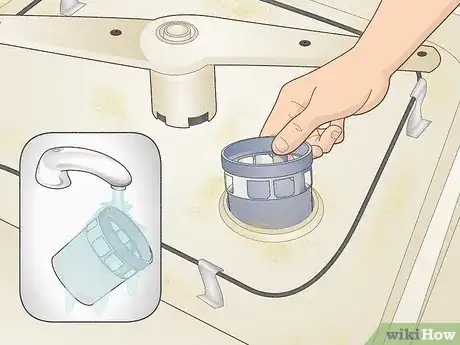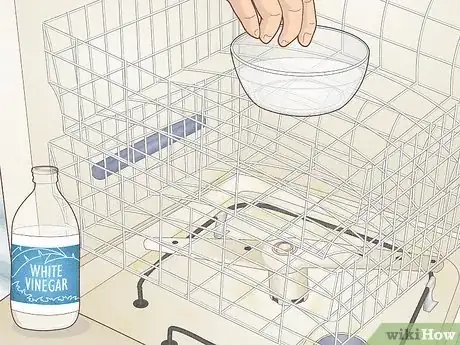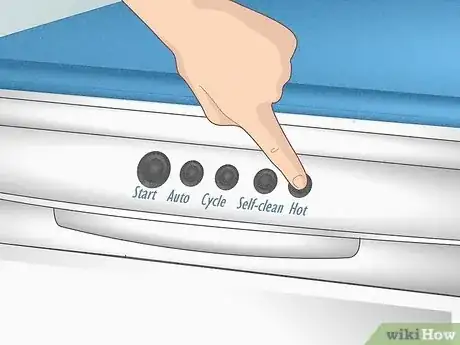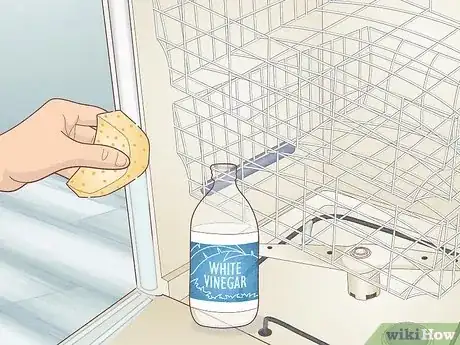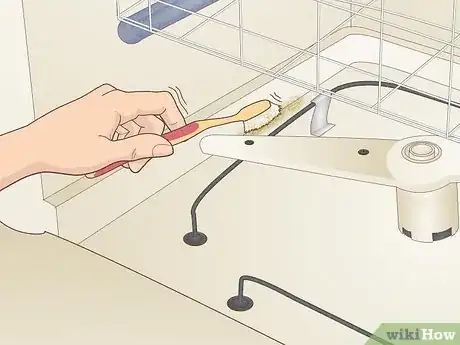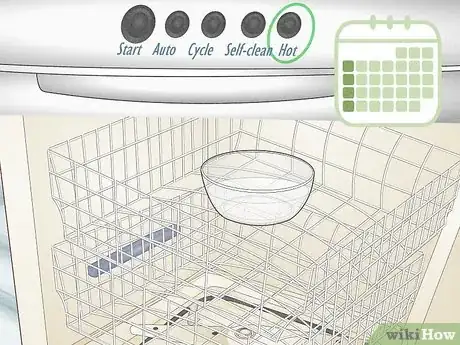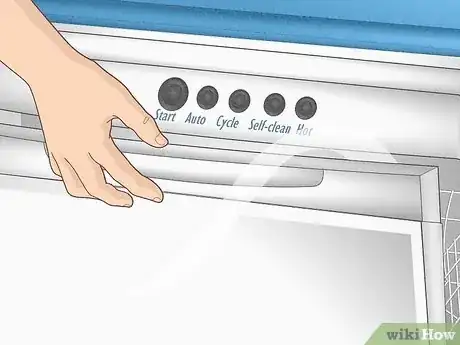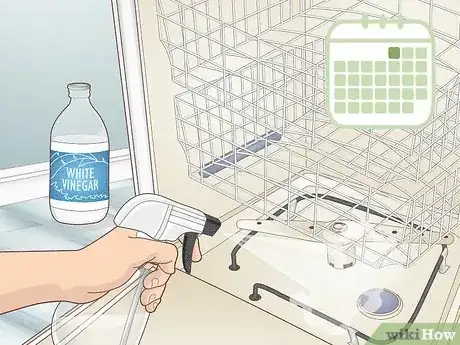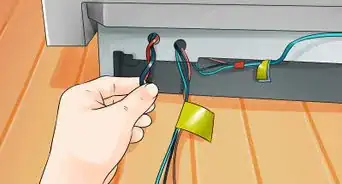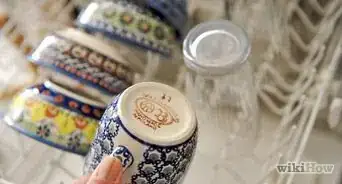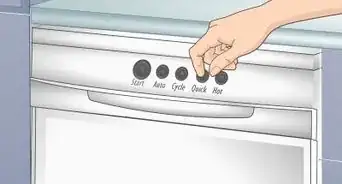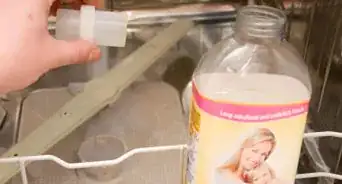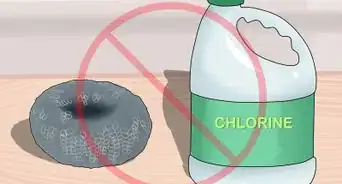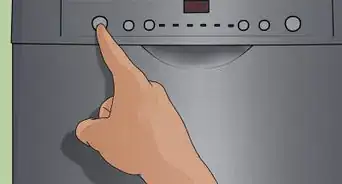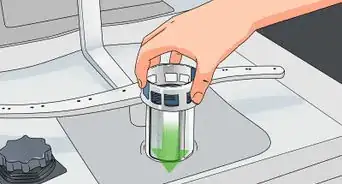This article was co-authored by Ashley Matuska and by wikiHow staff writer, Amber Crain. Ashley Matuska is a Professional Cleaner at the Founder and Owner of Dashing Maids in Denver, Colorado. Ashley has over seven years of experience in the cleaning industry. She and her team specialize in offering sustainable deep cleaning and maintenance cleaning services.
wikiHow marks an article as reader-approved once it receives enough positive feedback. In this case, 100% of readers who voted found the article helpful, earning it our reader-approved status.
This article has been viewed 199,152 times.
You rely on your dishwasher to keep dishes clean, but its moist and humid interior is the perfect environment for mold growth. If you're seeing black spots inside your dishwasher or keep catching a whiff of something funky, mold is likely to blame. In this article, we'll explain how you can easily get rid of mold, disinfect your dishwasher, and prevent mold from growing in the future. If you're ready to get your dishwasher sparkling clean, scroll on down!
Things You Should Know
- Remove any visible food and debris in the drain. Then, pop out the filter and scrub it with soapy water once a week.
- Fill a container with vinegar, put it on the top rack, and run a hot water cycle to disinfect the interior and get rid of mold.
- For lingering odors, sprinkle baking soda in the bottom of the dishwasher and run another hot water cycle.
- Run a vinegar and hot water cycle weekly to prevent mold. Once a month, scrub the nooks and crannies with straight vinegar for a deep clean.
Steps
Cleaning the Filter
-
1Slide out the bottom rack and scoop out any debris in the drain. The drain is located in the bottom center of the dishwasher. Reach your hand into the drain and remove any food chunks and visible debris.[1]
- Put on a pair of rubber gloves first to protect your hands.
-
2Remove the filter and hand-wash it with warm soapy water. If your dishwasher has a removable filter, it’ll be located in or around the drain. Grab the top of the filter, rotate it counter-clockwise, and lift it out. Take it over to the sink and give it a good scrub with a sponge.[2]
- The filter is prime real estate for food particles, bacteria, and fungal growth, so it's important to clean it weekly (or even daily if you use the dishwasher a lot).
- To remove stubborn food residue, gently scrub with an old toothbrush.
Advertisement -
3Rinse the filter with warm water and pop it back into place. After you rinse the filter thoroughly, you can put it straight back into the dishwasher (you don’t need to let it air dry). Rotate it clockwise to lock it in place.
- When you’re done, put the bottom dish rack back onto its rails.
Disinfecting with Vinegar
-
1Fill a container with 1 c (237ml) of vinegar and put it on the top rack. Remove any dishes inside so the dishwasher is empty (aside from your container of vinegar). Any dishwasher-safe container will do the trick for this, just make sure it doesn’t have a lid.[3]
- Vinegar is a natural disinfectant that kills mold and sanitizes surfaces effectively.
- Alternatively, you can put bleach in the cup instead of vinegar.[4]
-
2Run a hot water cycle so the vinegar can work its disinfecting magic. Select the longest and hottest cycle your dishwasher allows. Once the cycle starts, your dishwasher will disperse the vinegar and mix with the hot water to sanitize the inside.[5]
- You can also use the self-clean cycle if your dishwasher has one.
-
3Sprinkle a cup (237ml) of baking soda inside and run a short cycle. This is optional, but it can help deodorize any lingering odors that the vinegar didn’t knock out. Scatter the baking soda in the bottom of the dishwasher and run a short hot water cycle.[6]
-
4Wipe down the seals and door with straight vinegar. Soak a microfiber cloth or sponge in vinegar and run it along the door seals and the inside of the door. To be thorough, lift up the folds or ridges and slosh a bit of vinegar in the gap. Wait 10 minutes, then wipe the areas again with a clean cloth.[7]
-
5Scrub stubborn mold with an old toothbrush and vinegar. Your dishwasher should be sparkling at this point, but if you're still seeing moldy spots, hit them with vinegar again and tackle them with a cleaning brush. If there's a lingering funky odor, scrub the drain and spray arm with vinegar, as well.[8]
Preventing Mold
-
1Run a vinegar and a hot water cycle weekly. Just empty the dishwasher, pop a container of vinegar into the top rack, and run a hot water cycle to kill any fungi and bacteria lingering inside. Be sure to wipe down the door and seals with vinegar, as well.[9]
- If your dishwasher has a “sanitize” option, you can also use that.
-
2Leave the dishwasher door slightly ajar between uses. Trapped moisture and humidity are the perfect breeding ground for mold. After you run a cycle, leave the door open a crack to allow air to pass through the interior and dry the surface. Once it's dry, close the door.[10]
-
3Deep clean your dishwasher once a month. After running a hot water cycle with vinegar, spray vinegar directly into the nooks and crannies of your dishwasher (under the seals, the drain, the spray arm, and the back corners). Wait 10 minutes for the vinegar to kill anything living on the surface, then wipe everything down again with a clean cloth or sponge.
- To get down into the smaller crevices for a super deep clean, try using a toothpick or cotton swab.[11]
Expert Q&A
-
QuestionHow do I deep clean my dishwasher?
 Ashley MatuskaAshley Matuska is a Professional Cleaner at the Founder and Owner of Dashing Maids in Denver, Colorado. Ashley has over seven years of experience in the cleaning industry. She and her team specialize in offering sustainable deep cleaning and maintenance cleaning services.
Ashley MatuskaAshley Matuska is a Professional Cleaner at the Founder and Owner of Dashing Maids in Denver, Colorado. Ashley has over seven years of experience in the cleaning industry. She and her team specialize in offering sustainable deep cleaning and maintenance cleaning services.
Professional Cleaner Start by cleaning the filter. You should clean your dishwasher filter about every 3 months or so by rinsing it under running water.
Start by cleaning the filter. You should clean your dishwasher filter about every 3 months or so by rinsing it under running water. -
QuestionI can’t get the filter out my dishwasher. It’s a 2003 or 2004 by Maytag Quiet series 300.
 wikiHow Staff EditorThis answer was written by one of our trained team of researchers who validated it for accuracy and comprehensiveness.
wikiHow Staff EditorThis answer was written by one of our trained team of researchers who validated it for accuracy and comprehensiveness.
Staff Answer wikiHow Staff EditorStaff AnswerSome older dishwashers may not have removable filters. Try contacting Maytag for information on your specific model or look for the user manual online.
wikiHow Staff EditorStaff AnswerSome older dishwashers may not have removable filters. Try contacting Maytag for information on your specific model or look for the user manual online.
References
- ↑ https://www.bobvila.com/articles/how-to-clean-a-dishwasher/
- ↑ https://www.insider.com/guides/kitchen/how-to-clean-dishwasher
- ↑ https://www.bobvila.com/articles/how-to-clean-a-dishwasher/#.WPkLYpArI1I
- ↑ https://www.insider.com/guides/kitchen/how-to-clean-dishwasher
- ↑ https://www.bobvila.com/articles/how-to-clean-a-dishwasher/
- ↑ https://www.bobvila.com/articles/how-to-clean-a-dishwasher/
- ↑ https://www.nytimes.com/wirecutter/guides/how-to-clean-dishwasher-of-mold/
- ↑ https://www.bobvila.com/articles/how-to-clean-a-dishwasher/#.WP7JNZArLEY
- ↑ https://www.bobvila.com/articles/how-to-clean-a-dishwasher/
About This Article
To clean a moldy dishwasher, start by putting 1 cup of vinegar into a small bowl and placing it in the top rack of an empty dishwasher. Then, run a hot water cycle so the vinegar can work to remove the grime and mold during the wash. Next, sprinkle 1 cup of baking soda over the bottom of the dishwasher and let it sit overnight. The next morning, run another hot water cycle to remove any remaining odors from the mold. Finally, use a toothbrush and soapy water to scrub any nooks and crannies that still have mold in them. For tips on how to clean the filter in your dishwasher to prevent mold, read on!


